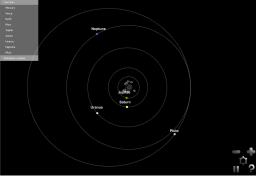Emily Lakdawalla • May 02, 2008
Solar systems in motion
Another item from the "just plain cool" department: here is a website with a neat little application that shows the motions of bodies in our solar system: the Solar System Visualizer. You can just watch it spin and spin and see how fast we go around the sun compared to the outer planets, then zoom in and see how Mercury outpaces us. You can zoom to individual planets to see solar systems in miniature, and get a sense of how truly weird it is that Triton orbits Neptune backwards compared to all the other large moons and planets in the solar system. Then you can zoom elsewhere, following the menus to show you the orbital motions of planets in extrasolar planetary systems. My favorite aspect of this visualization is how orbital speed scales with zoom level, so you never need to fiddle with temporal controls. Kudos to the student team of Michael VanDaniker and Andrew Lund, who developed the visualizer with rings researcher Doug Hamilton as their advisor. Here's two screen caps, one of the whole solar system and one of the inner part of the Saturn system.

Michael VanDaniker, Andrew Lund, and Douglas Hamilton
Solar System Visualizer
The Solar System Visualizer shows the solar system in motion, with bodies displayed at correct relative distance and speed (but not size).Some fun things to watch for: zoom in to where you can see Mars and Earth, and see how often the two line up on the same side of the Sun. Keep track of where it happened last time, and where it happens the next time. Now do you understand why Mars launch opportunities happen 26 months apart? Zoom out to where you can see the outer solar system, and muse on how rare it is for the outer planets to line up with Jupiter a little behind Saturn, Saturn a little behind Uranus, and Uranus a little behind Neptune, to permit such a thing as a Voyager 2 grand tour. Look at how bodies at the same distance from the Sun in the asteroid belt can be going at very different speeds, depending on how elliptical their orbits are and whether they're near aphelion or perihelion or in between. See if you can notice how Mars' relatively elliptical orbit makes it go much faster at one part of its year than at another part.


 Explore Worlds
Explore Worlds Find Life
Find Life Defend Earth
Defend Earth

